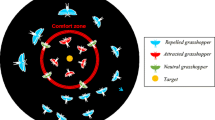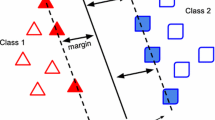Abstract
The Support Vector Machines (SVM) constitute a very powerful technique for pattern classification problems. However, its efficiency in practice depends highly on the selection of the kernel function type and relevant parameter values. Selecting relevant features is another factor that can also impact the performance of SVM. The identification of the best set of parameters values for a classification model such as SVM is considered as an optimization problem. Thus, in this paper, we aim to simultaneously optimize SVMs parameters and feature subset using different kernel functions. We cast this problem as a multi-objective optimization problem, where the classification accuracy, the number of support vectors, the margin and the number of selected features define our objective functions. To solve this optimization problem, a method based on multi-objective genetic algorithm NSGA-II is suggested. A multi-criteria selection operator for our NSGA-II is also introduced. The proposed method is tested on some benchmark data-sets. The experimental results show the efficiency of the proposed method where features were reduced and the classification accuracy has been improved.




Similar content being viewed by others
Explore related subjects
Discover the latest articles, news and stories from top researchers in related subjects.Notes
available at http://www.csie.ntu.edu.tw/~cjlin/.
available at http://archive.ics.uci.edu/ml/.
References
Andy, Fernando M, Halim K, Sanjaya G (2015) Optimization features using GA-SVM approach. Int J Sci Res 4(9):193–197
Balakrishnan S, Narayanaswamy R (2009) Feature selection using fcbf in type ii diabetes databases. In: International conference on IT to celebrate S Charmonman’s 72nd Birthday, Thailand
Chapelle O, Vapnik V, Bousquet O, Mukherjee S (2002) Choosing multiple parameters for support vector machines. Mach Learn 46(1):131–159
Chen Z, Lin T, Tang N, Xia X (2016) A parallel genetic algorithm based feature selection and parameter optimization for support vector machines. Sci Program 2016:2739621
Chung K, Kao W, Sun C, Lin C (2003) Radius margin bounds for support vector machines with RBF kernel. Neural Comput 15(11):2643–2681
Deb K, Pratap A, Agarwal S, Meyarivan T (2002) A fast and elitist multi-objective genetic algorithm: NSGA-II. IEEE Trans Evol Comput 6(2):182–197
Deb K, Beyer H (1999) Self-adaptive genetic algorithms with simulated binary crossover. Complex Syst 9:431–454
Deb K, Tiwari S (2008) Omni-optimizer: a generic evolutionary algorithm for single and multiobjective optimization. Eur J Oper Res 185(3):1062–1087
Frohlich H, Chapelle O (2003) Feature selection for support vector machines by means of genetic algorithms. In: Proceedings of the 15th IEEE international conference on tools with artificial intelligence, Sacramento, CA, USA, pp 142–148
Guyon I, Weston J, Barnhill S, Vapnik V (2002) Gene selection for cancer classification using support vector machines. Mach Learn 46(1–3):389–422
Guyon I, Gunn S, Nikravesh M, Zadeh L (2006) Feature extraction, foundations and applications. Springer, Berlin
Guyon I, Elisseeff A (2003) An introduction to variable and feature selection. J Mach Learn Res 3:1157–1182
Hsu C, Lin C (2002) A comparison of methods for multiclass support vector machines. IEEE Trans Neural Netw 13(2):415–425
Huang C, Wang C (2006) A ga-based feature selection and parameters optimization for support vector machine. Expert Syst Appl 31(2):231–240
Keerthi S, Lin C (2003) Asymptotic behaviors of support vector machines with gaussian kernel. Neural Comput 15:1667–1689
Kotsia I, Pitas I (2007) Facial expression recognition in image sequences using geometric deformation features and support vector machines. IEEE Trans Image Process 16(1):172–187
Lee M (2009) Using support vector machine with a hybrid feature selection method to the stock trend prediction. Expert Syst Appl 36:10896–10904
Liang X, Liu F (2002) Choosing multiple parameters for svm based on genetic algorithm. In: 6th international conference on signal processing, vol 1, pp 117–119
Liao P, Zhang X, Li K, Fu Y, Wang M, Wang S (2015) Parameter optimization for support vector machine based on nested genetic algorithms. J Autom Control Eng 3(6):507–511
Lin K-C, Huang Y-H, Hung J-C, Lin Y-T (2015) Feature selection and parameter optimization of support vector machines based on modified cat swarm optimization. Int J Distrib Sens Netw 2015:365869
Lin S, Ying K, Chen S, Lee Z (2008) Particle swarm optimization for parameter determination and feature selection of support vector machines. Expert Syst Appl 35(4):1817–1824
Liu H, Wang Y, Lu X (2005a) A method to choose kernel function and its parameters for support vector machines. Proc IEEE Int Conf Mach Learn Cybern 7:4277–4280
Liu S, Jia C, Ma H (2005b) A new weighted support vector machine with ga-based parameter selection. In: Proceedings of 2005 international conference on machine learning and cybernetics, vol 7, pp 4351–4355
Ma J, Nguyen M, Rajapakse J (2009) Gene classification using codon usage and support vector machines. ACM Trans Comput Biol Bioinf 6(1):134–143
Mao K (2004) Feature subset selection for support vector machines through discriminative function pruning analysis. IEEE Trans Syst Man Cybern 34(1):60–67
Melgani F, Bazi Y (2008) Classification of electrocardiogram signals with support vector machines and swarm optimization. IEEE Trans Inf Technol Biomed 12(5):667–677
Pardo M, Sberveglieri G (2005) Classification of electronic nose data with support vector machines. Sens Actuators B Chem 107:730–737
Plat J (1999) Fast training of support vector machine using sequential minimal optimization. In: Smola A (ed) Advances in kernel methods? Support vector learning. MIT Press, Cambridge
Quang A, Zhang Q, Li X (2002) Evolving support vector machine parameters. In: Proceedings of 2002 international conference on machine learning and cybernetics, pp 548–551
Raymer M, Punch W, Goodman E, Kuhn L, Jain A (2000) Dimensionality reduction using genetic algorithms. IEEE Trans Evol Comput 4(2):164–171
Rinaldia F, Sciandronea M (2010) Feature selection combining linear support vector machines and concave optimization. Optim Methods Softw 25(1):117–128
Rojas S, Fernandez-Reyes D (2005) Adapting multiple kernel parameters for support vector machines using genetic algorithms. In: The 2005 IEEE Congress on Evolutionary Computation, vol 1, pp 626–631
Thadani K, Jayaraman V, Sundararajan V (2006) Evolutionary selection of kernels in support vector machines. In: Proceedings of IEEE international conference on advanced computing and communications, pp 19–24
Vapnik V (1995) The nature of statistical learning theory. Springer, New York
Wu CH, Tzeng GH, Lin RH (2009) A Novel hybrid genetic algorithm for kernel function and parameter optimization in support vector regression. Expert Syst Appl 36:4725–4735
Xue B, Zhang M, Browne W-N, Yao X (2016) A survey on evolutionary computation approaches to feature selection. IEEE Trans Evol Comput 20(4):606–626
Yang J, Honavar V (1998) Feature subset selection using a genetic algorithm. IEEE Intell Syst 13(2):44–49
Yu L, Chen H, Wang S, Lai K (2009) Evolving least squares support vector machines for stock market trend mining. IEEE Trans Evol Comput 13(1):87–102
Yuan FC (2012) Parameters optimization using genetic algorithms in support vector regression for sales volume forecasting. Appl Math 3:1480–1486
Yuxia H, Hongtao Z (2012) Chaos optimization method of SVM parameters selection for chaotic time series forecasting. Phys Proc 25(2012):588–594 2012 international conference on solid state devices and materials science
Zhang G (2000) Neural network for classification: a survey. IEEE Trans Syst Man Cybern Part C Appl Rev 30(4):451–462
Zhao M, Fu C, Ji L, Tang K, Zhou M (2011) Feature selection and parameter optimization for support vector machines: a new approach based on genetic algorithm with feature chromosomes. Expert Syst Appl 38(5):5197–5204
Author information
Authors and Affiliations
Corresponding author
Rights and permissions
About this article
Cite this article
Bouraoui, A., Jamoussi, S. & BenAyed, Y. A multi-objective genetic algorithm for simultaneous model and feature selection for support vector machines. Artif Intell Rev 50, 261–281 (2018). https://doi.org/10.1007/s10462-017-9543-9
Published:
Issue Date:
DOI: https://doi.org/10.1007/s10462-017-9543-9




